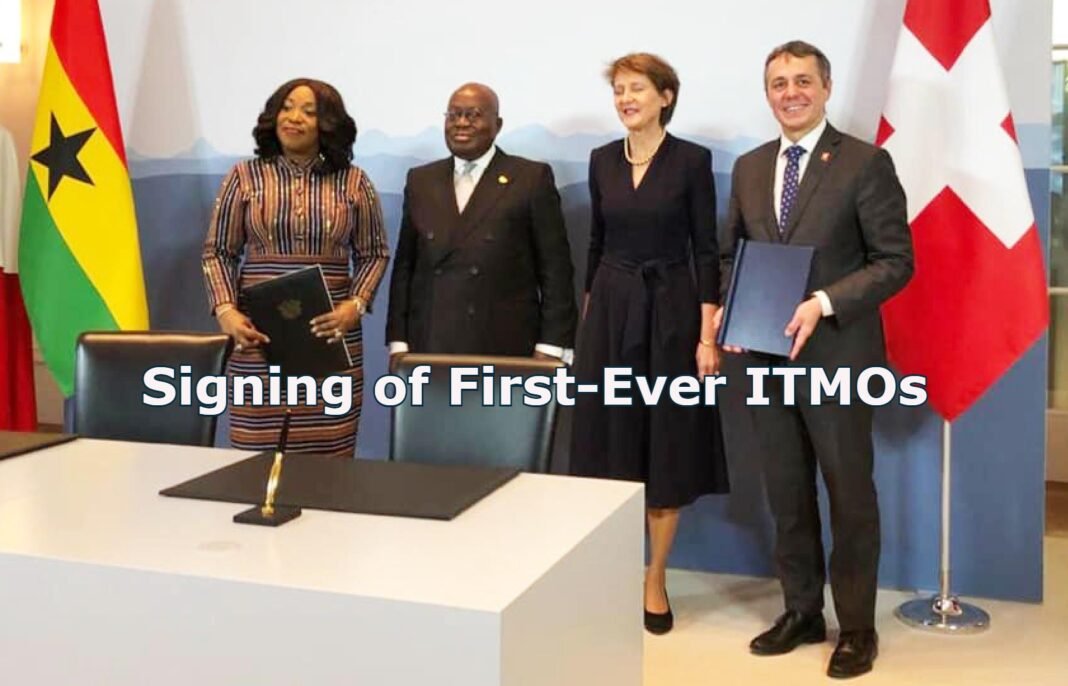Ghana and Switzerland, along with Vanuatu, have approved at COP27 the first-ever voluntary cooperation under Article 6.2 of the Paris Agreement called the Internationally Transferred Mitigation Outcome (ITMO).
ITMO is a carbon emissions trading system where countries can purchase or trade carbon credits from other countries. This can open the door to creating new carbon markets and larger reductions in global GHG emissions.
The countries showed during the summit how the pioneering ITMO transaction will enable the reduction of greenhouse gas (GHG) emissions while promoting the Sustainable Development Goals (SDGs) in developing nations.
According to the United Nations Development Programme, commenting on this collaboration, UNDP Administrator said that:
“This initiative is an example of UNDP’s ‘future-smart’ approach to development, which aims to use innovative financial mechanisms and partnerships with governments and the private sector to empower countries to follow a sustainable development pathway, leaving no one behind…”
The First-Ever Approved ITMO
Article 6 of the Paris Agreement replaces previous forms of international carbon credits.
It recognizes that some countries may enter voluntary cooperation in implementing their Nationally Determined Contributions (NDCs) to allow for higher climate mitigation ambition and actions and promote sustainable development.
Apart from cutting emissions, climate mitigation projects can also deliver many development benefits. These include gender empowerment, food security, access to energy, livelihood support, job creation, and more.
-
ITMO trading allows countries in under-compliance to buy ITMOs from countries in over-compliance.
At COP27, Ghana presented the landmark bilateral authorized project under ITMO deal with Switzerland. Meanwhile, Vanuatu also did the same for the first-ever unilateral ITMO projects.
By entering into bilateral agreements with Ghana and Vanuatu, Switzerland will reduce its GHG emissions by using ITMOs. Doing so will help the implementation of projects with development benefits.
The project in Ghana will help thousands of rice farmers practice sustainable agriculture to cut methane emissions. These farmers cover about 80% of Ghana’s rice production.
Via the ITMO deal, those farmers will also get extra income with carbon revenues for increased resilience and more efficient water use.
A representative from Ghana, Dr. Kwaku Afriyie, remarked that:
“Ghana’s leadership in Africa on carbon finance with the landmark bilateral agreement with Switzerland is something we are proud of. We want to leverage this collaborative approach to crowd in more carbon revenue to accelerate the implementation of our national climate plan for the benefits of many communities…”
While the deal with Vanuatu will provide access to electricity to those who don’t have it through renewable energy sources. Vanuatu is a small Island Developing State (SIDS).
Creating Demand for ITMOs
The UN Development Programme (UNDP) is among the first to create strong demand for ITMOs via its Carbon Payment for Development facility. Through this initiative, the UNDP will help design and implement mitigation projects.
The goal is to leverage carbon markets to enable private investments to support SDGs. New projects can help reduce up to 2.3 million tCO2 equivalents. To amplify the impact of these projects, UNDP will focus on the ones supported by the private sector.
It will channel payments for ITMOs to project proponents who invest in low-carbon solutions that create additional revenue for investors.
- Under this payment-for-result scheme, investments from the private sector will be up to 4x the carbon payments from the ITMOs.
UNDP launched at COP27 a new digital platform called Carbon Cooperation to help developing countries build capacity, enhance ITMO workflows, and improve their carbon market readiness. It will also make their ITMO projects become more efficient and transparent.
In partnership with UNFCCC, UNDP also introduced its Article 6.2 capacity development online course.
The course seeks to equip participants in making decisions related to cooperative approaches such as the first-ever ITMO agreement between Ghana and Switzerland. It will also help policymakers understand the vital components of executing this new carbon market mechanism in their country.

